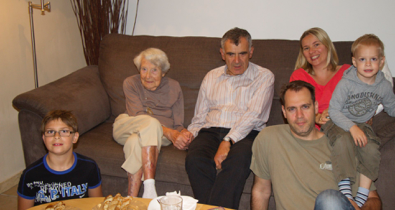
This post summarizes my experiences for my children, and links (via the dates) to hundreds of photographs stored at Flickr.
7/8/2014
 |
I visited my relatives in
Hungary this summer for a week and a half in July. I
wanted to see my 94 year old aunt and her small but
multi-generational family. My cousin Jani (János Angyal,
officially) and I took a number of road trips around
Hungary, where the compact size of the country makes it
possible to drive to a distant part of the country and
back in a single day. This post summarizes my experiences for my children, and links (via the dates) to hundreds of photographs stored at Flickr. |
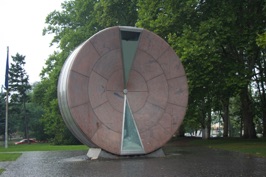 We started Tuesday with a light schedule,
going to the Fine Arts Museum, where we saw a great exhibit of
Toulouse Lautrec prints, of which this museum has a huge collection
(~400 original prints). These are mostly lithographs, and I
was really impressed at the quality of his drawings and the fact
that he could suggest people's character with just a few "just so"
lines. In a way, it suggests Picasso's skill later in the last
century -- Lautrec died in 1901. We also toured the 17th
century Italian masters, part of their excellent collection of
similar era Dutch painters, and then walked around the area of the
"Square of Heroes", where I saw a rather modern memorial to the
events of 1956, and an "eternal" clock built in 2000 to celebrate
Hungary's joining the EU, which is a giant hourglass embedded in a
huge circular stone, with bearings under it to allow it to be turned
(manually) once a year. It's huge, so the sand takes a year to
flow through. Alas, it is already broken; so much for
eternity.
We started Tuesday with a light schedule,
going to the Fine Arts Museum, where we saw a great exhibit of
Toulouse Lautrec prints, of which this museum has a huge collection
(~400 original prints). These are mostly lithographs, and I
was really impressed at the quality of his drawings and the fact
that he could suggest people's character with just a few "just so"
lines. In a way, it suggests Picasso's skill later in the last
century -- Lautrec died in 1901. We also toured the 17th
century Italian masters, part of their excellent collection of
similar era Dutch painters, and then walked around the area of the
"Square of Heroes", where I saw a rather modern memorial to the
events of 1956, and an "eternal" clock built in 2000 to celebrate
Hungary's joining the EU, which is a giant hourglass embedded in a
huge circular stone, with bearings under it to allow it to be turned
(manually) once a year. It's huge, so the sand takes a year to
flow through. Alas, it is already broken; so much for
eternity. The next day we took a trip to
Szombathely, near the Austrian border, to check out Mom's intuition
about the likely presence of a Roman town half-way between Gorsium,
a set of Roman ruins I had visited on an earlier trip with Jani, and
Szombathely, which in Roman times was called Savaria. She had
designed such a town as part of a MOOC she was taking on Roman
architecture, and thought that location would be ideal for it.
Well, her intuition is very good, because one of the first things I
saw in Szombathely was a map placing the Roman town of Mogentiana
just where she expected it, though in those times it was on a road
connecting Savaria with Aquincum (Buda), not Gorsium. There is
still some controversy about exactly where the town was, but the map
agrees with her. We also visited the town of Kőszeg, just on
the Austrian border, which is beautiful and well
preserved/reconstructed.
The next day we took a trip to
Szombathely, near the Austrian border, to check out Mom's intuition
about the likely presence of a Roman town half-way between Gorsium,
a set of Roman ruins I had visited on an earlier trip with Jani, and
Szombathely, which in Roman times was called Savaria. She had
designed such a town as part of a MOOC she was taking on Roman
architecture, and thought that location would be ideal for it.
Well, her intuition is very good, because one of the first things I
saw in Szombathely was a map placing the Roman town of Mogentiana
just where she expected it, though in those times it was on a road
connecting Savaria with Aquincum (Buda), not Gorsium. There is
still some controversy about exactly where the town was, but the map
agrees with her. We also visited the town of Kőszeg, just on
the Austrian border, which is beautiful and well
preserved/reconstructed. Thursday we began by visiting a friend of Jani in
Szentendre, with whom it turns out Jani participates in
demonstrations against the current government's anti-Semitism and
(as they perceive it) their general corruption. Then we went
on to Skanzen, an outdoor cultural history museum, where they have
collected buildings from various regions of Hungary and have a small
number of people like the ones we remember at Sturbridge or Mystic,
enacting life in those times and places. They showed a lot of
agriculture, a shoemaker's shop (interesting to both Jani and me
because of our shoemaking heritage – my Uncle Imre, Jani’s father,
was a shoemaker, as were my dad and both my grandfathers), a dry
goods store run by a Jewish entrepreneur, a windmill for grinding
grain, a cloth dyer's shop, etc. It's remarkable how much of a
variety we saw among styles in different parts of a very small
country. In the afternoon, Jani was busy taking Panni to a doctor's
appointme
Thursday we began by visiting a friend of Jani in
Szentendre, with whom it turns out Jani participates in
demonstrations against the current government's anti-Semitism and
(as they perceive it) their general corruption. Then we went
on to Skanzen, an outdoor cultural history museum, where they have
collected buildings from various regions of Hungary and have a small
number of people like the ones we remember at Sturbridge or Mystic,
enacting life in those times and places. They showed a lot of
agriculture, a shoemaker's shop (interesting to both Jani and me
because of our shoemaking heritage – my Uncle Imre, Jani’s father,
was a shoemaker, as were my dad and both my grandfathers), a dry
goods store run by a Jewish entrepreneur, a windmill for grinding
grain, a cloth dyer's shop, etc. It's remarkable how much of a
variety we saw among styles in different parts of a very small
country. In the afternoon, Jani was busy taking Panni to a doctor's
appointme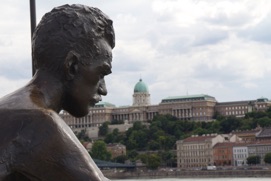 nt, and I spent the afternoon
wandering around the banks of the Duna (Danube). In the
evening, Jani and I went to a Beethoven concert (the Egmont
Overture, his Violin Concerto, and the 4th Symphony) in the
courtyard of the Hajduhunyadi Castle, that pretend construction in
the Liget that brings together castle styles from all different eras
in a single extended building. Except for the threat of rain,
it was very pleasant, and a good orchestra and soloist. The
soloist kept glancing at the sky, hoping not to get his precious
violin wet; we only got a few drops.
nt, and I spent the afternoon
wandering around the banks of the Duna (Danube). In the
evening, Jani and I went to a Beethoven concert (the Egmont
Overture, his Violin Concerto, and the 4th Symphony) in the
courtyard of the Hajduhunyadi Castle, that pretend construction in
the Liget that brings together castle styles from all different eras
in a single extended building. Except for the threat of rain,
it was very pleasant, and a good orchestra and soloist. The
soloist kept glancing at the sky, hoping not to get his precious
violin wet; we only got a few drops.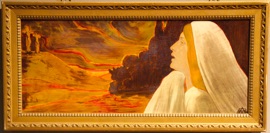 Friday, July
11
Friday, July
11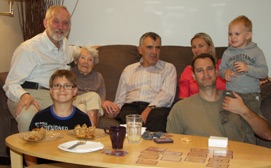 their three year old son, who is a
hellion, physically driven little kid. Tomi and Ancsa look
like they are doing well financially, though always worried about
teetering on the edge of economic collapse as a result of
geopolitics, the economic policies of the government, and Tomi's
fear of losing his well-paid job. They wonder whether they
would have been smarter to leave Hungary, as some of their friends
have, but they note that Hungarian savings don't go far in the more
developed parts of Europe, and many who do leave wind up getting
only temporary work abroad and come back.
their three year old son, who is a
hellion, physically driven little kid. Tomi and Ancsa look
like they are doing well financially, though always worried about
teetering on the edge of economic collapse as a result of
geopolitics, the economic policies of the government, and Tomi's
fear of losing his well-paid job. They wonder whether they
would have been smarter to leave Hungary, as some of their friends
have, but they note that Hungarian savings don't go far in the more
developed parts of Europe, and many who do leave wind up getting
only temporary work abroad and come back. UNIVERSITY DISTRICT
UNIVERSITY DISTRICT POLGÁR,
DERECSKE, DEBRECEN
POLGÁR,
DERECSKE, DEBRECEN 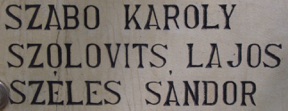 In
Derecske, I found the WWI memorial on which my grandfather's name
appears as one of the war dead, and we wandered the neighborhood
where Apu was born and lived for the first 10 years of life, though
I could not remember exactly where his house had been (Mom and I
were there in 1983), and most of those old houses had been torn down
and rebuilt to modern standards. I spoke with an elderly lady who
tried to help, but didn't know much about where our family's house
might have been. I had heard from Vera's family that the house
was gone some time ago, but I would still have liked to see the
site. Debrecen is a nicely fixed up city, at least in the main
squares; it's in poorer shape in the side streets. According to
Jani, most investments to fix things up (including the wonderful new
highways everywhere) are from the EU, because Hungary just doesn't
have much money.
In
Derecske, I found the WWI memorial on which my grandfather's name
appears as one of the war dead, and we wandered the neighborhood
where Apu was born and lived for the first 10 years of life, though
I could not remember exactly where his house had been (Mom and I
were there in 1983), and most of those old houses had been torn down
and rebuilt to modern standards. I spoke with an elderly lady who
tried to help, but didn't know much about where our family's house
might have been. I had heard from Vera's family that the house
was gone some time ago, but I would still have liked to see the
site. Debrecen is a nicely fixed up city, at least in the main
squares; it's in poorer shape in the side streets. According to
Jani, most investments to fix things up (including the wonderful new
highways everywhere) are from the EU, because Hungary just doesn't
have much money.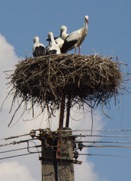
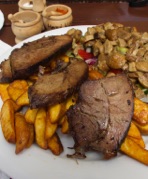
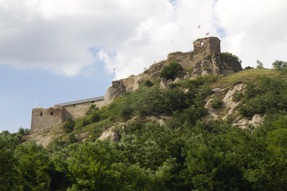 MÁTRA, EGER
MÁTRA, EGER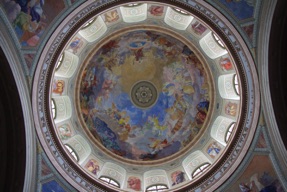 Eger eventually surrendered, but the
Turkish army went no further north, having been exhausted in the
battle. One of the pictures is Jani standing in front of an antique
store, which is actually the location of the house where Uncle Imre,
Aunt Panni and Jani lived after WWII. I only realized the next
day, talking to Panni, that this was in fact where my grandparents
had lived and where my mother spent her girlhood years.
However, the house is not the original one. It was torn down
about a decade ago, but rebuilt in a very similar style, though this
time with better plumbing and electric wiring in the walls. As
on many of our trips, we saw beautiful clouds in the sky as we
returned to Budapest, and got a nice car-wash from an intense but
brief rainstorm.
Eger eventually surrendered, but the
Turkish army went no further north, having been exhausted in the
battle. One of the pictures is Jani standing in front of an antique
store, which is actually the location of the house where Uncle Imre,
Aunt Panni and Jani lived after WWII. I only realized the next
day, talking to Panni, that this was in fact where my grandparents
had lived and where my mother spent her girlhood years.
However, the house is not the original one. It was torn down
about a decade ago, but rebuilt in a very similar style, though this
time with better plumbing and electric wiring in the walls. As
on many of our trips, we saw beautiful clouds in the sky as we
returned to Budapest, and got a nice car-wash from an intense but
brief rainstorm. On Tuesday morning, we wandered around
Veresegyház, where Jani lives. It's an old village, one time
an agricultural place, but now a commuter suburb of Budapest, though
there are still fields around town, and Jani's neighbors do keep
chickens, pigs and a sheep. Jani only has a friendly old dog and a
bunch of cats. Later we visited the Roman ruins at Aquincum,
which is in the "old Buda" part of Budapest, where the road to
Vienna started both in Roman and modern times. Like at most
Roman ruins, the buildings were mostly demolished to re-use their
stones, so only the low walls remain to show the layout of the
town. But you can see the temples, baths, and villas that
probably made for a comfortable lifestyle 2000 years ago. The
museum has also rebuilt one building on its ancient foundation,
though it looks fake. They have an interesting collection of broken
statuary and funereal markers, and a big museum building with
mosaics and everyday items recovered from the site. We then
drove out to Győr, on the road to Vienna, which is another nicely
spiffed-up town, with a pedestrian district full of cafes and
restaurants in the historic part of the city. My only
childhood recollection of Győr is that it is one of the places
through which we tried to escape after the Hungarian revolution in
1956, but our intended guide had been detained by the security
police, so we had no way to get from there to the border. We
thus spent the day as the tourists we were pretending to be, and
returned to Budapest, to try again later. The town then was a
grimy industrial city, so its tourism has improved greatly.
There is still a big Audi factory there, but the belching steel
mills have shut down, like they did in Pittsburgh, as Chinese labor
is still cheaper than Hungarian.
On Tuesday morning, we wandered around
Veresegyház, where Jani lives. It's an old village, one time
an agricultural place, but now a commuter suburb of Budapest, though
there are still fields around town, and Jani's neighbors do keep
chickens, pigs and a sheep. Jani only has a friendly old dog and a
bunch of cats. Later we visited the Roman ruins at Aquincum,
which is in the "old Buda" part of Budapest, where the road to
Vienna started both in Roman and modern times. Like at most
Roman ruins, the buildings were mostly demolished to re-use their
stones, so only the low walls remain to show the layout of the
town. But you can see the temples, baths, and villas that
probably made for a comfortable lifestyle 2000 years ago. The
museum has also rebuilt one building on its ancient foundation,
though it looks fake. They have an interesting collection of broken
statuary and funereal markers, and a big museum building with
mosaics and everyday items recovered from the site. We then
drove out to Győr, on the road to Vienna, which is another nicely
spiffed-up town, with a pedestrian district full of cafes and
restaurants in the historic part of the city. My only
childhood recollection of Győr is that it is one of the places
through which we tried to escape after the Hungarian revolution in
1956, but our intended guide had been detained by the security
police, so we had no way to get from there to the border. We
thus spent the day as the tourists we were pretending to be, and
returned to Budapest, to try again later. The town then was a
grimy industrial city, so its tourism has improved greatly.
There is still a big Audi factory there, but the belching steel
mills have shut down, like they did in Pittsburgh, as Chinese labor
is still cheaper than Hungarian.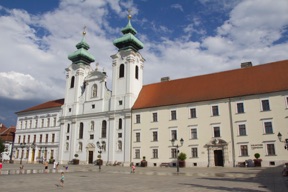 On
Wednesday, we visited a Cistercian monastery in Zirc, where we were
guided around by a young monk who seemed very witty and
modern. The place dates back to the middle ages, though it lay
fallow during the Turkish occupation, when Christian institutions
were not much in favor. The monks who re-established it after
the Turks were driven out decided that their old-fashioned church
and dwellings were no long appropriate, so they used the stones to
build a grand Baroque structure. We then headed to the
northern shore of Lake Balaton, the great Hungarian resort spot,
where we had a nice lunch, walked around Tihany's church and another
old monastery on a peninsula sticking out into the lake, with great
views, and got another sudden, intense but brief storm while we were
trying to sit outside at a cafe in a classy little resort town,
Balatonfüred, where the jet setters of the 1920's relaxed.
On
Wednesday, we visited a Cistercian monastery in Zirc, where we were
guided around by a young monk who seemed very witty and
modern. The place dates back to the middle ages, though it lay
fallow during the Turkish occupation, when Christian institutions
were not much in favor. The monks who re-established it after
the Turks were driven out decided that their old-fashioned church
and dwellings were no long appropriate, so they used the stones to
build a grand Baroque structure. We then headed to the
northern shore of Lake Balaton, the great Hungarian resort spot,
where we had a nice lunch, walked around Tihany's church and another
old monastery on a peninsula sticking out into the lake, with great
views, and got another sudden, intense but brief storm while we were
trying to sit outside at a cafe in a classy little resort town,
Balatonfüred, where the jet setters of the 1920's relaxed.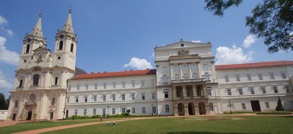
 Thursday was my flight home, from
which I didn't take any interesting pictures. Overall, I had a
wonderful time, except for a tragedy that happened the morning of my
arrival, when the boyfriend of Jani's step-daughter Timi died
suddenly, at age 32, of a cardiac arrhythmia. He had no earlier
symptoms. She was, of course, devastated, but perhaps my
presence provided a bit of a welcome distraction.
Thursday was my flight home, from
which I didn't take any interesting pictures. Overall, I had a
wonderful time, except for a tragedy that happened the morning of my
arrival, when the boyfriend of Jani's step-daughter Timi died
suddenly, at age 32, of a cardiac arrhythmia. He had no earlier
symptoms. She was, of course, devastated, but perhaps my
presence provided a bit of a welcome distraction.